Two comets, one naked-eye. UPDATE JULY 9: Comet NEOWISE was as bright as hoped when it swung out of its July 3rd perihelion into the low morning sky. It's dimly visible to the naked eye, though binoculars do better, and pretty tiny. Chris Schur of Payson, Arizona, wrote on July 5th, "The comet continues to be stunning, rising tail-first over the plateau some 20 miles distant. I was able to easily see it naked eye with about a degree of tail visually. Gorgeous yellow color in the scope."
It's currently about magnitude 2, but atmospheric extinction at its low altitude, and its involvement with morning twilight, reduce its visibility compared to what that magnitude might suggest.
Scan for it with binoculars very low in the northeast, below or lower left of Capella, as dawn is beginning: starting roughly 1 hour 45 minutes before your local sunrise time. (This applies to the world's mid-northern latitudes.) Day by day NEOWISE is losing brightness. Around July 14th its best visibility will switch from the dawn to the evening sky, low in the north-northwest around the end of twilight. By then it's likely to be magnitude 3 or 4. From then on it will gain altitude in late twilight as it fades further.
Meanwhile Comet Lemmon, a much fainter target for telescopes at magnitude 7.5 or so, low due west at the end of twilight. It's heading from Leo into Virgo, gaining altitude daily as it too continues to fade. See Bob King's Anticipation Grows for Comets NEOWISE and Lemmon and Comet NEOWISE Delights at Dawn.
Two supernovae for amateur telescopes have recently erupted in the western evening sky, both 12th magnitude and both in the Virgo Galaxy Cluster: in M85 and NGC 4457. See Bob King's Two Bright Supernovae Light Up Nearby Galaxies, with finder charts and photos.
FRIDAY, JULY 3
■ To skywatchers whose view low in the north is obstructed, "Cassiopeia in July" might sound as wrong as Christmas in July. But already Cas has passed its lowest evening position of the year, and it is gradually gaining altitude toward the coming fall and winter. Look for its flattened W shape low in the north-northeast these nights. The W is no longer level.
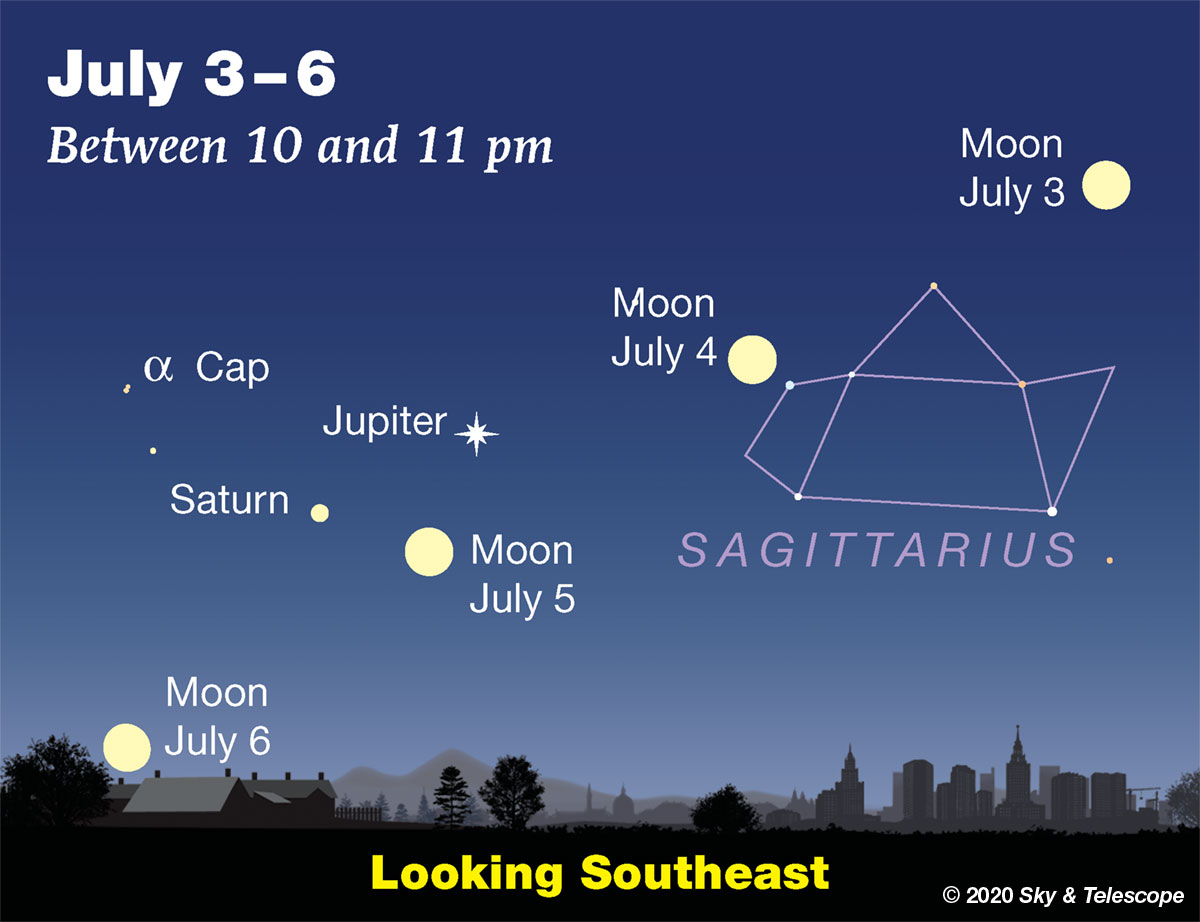
SATURDAY, JULY 4
■ Full Moon (exactly full at 12:44 a.m. tonight EDT). This evening the Moon shines next to the handle of the Sagittarius Teapot, as shown above. How much of the Teapot can you see through the moonlight? It's about the size of your fist at arm's length.
Much easier are bright Jupiter and Saturn, shining to the Moon's lower left.
■ The Moon will undergo a very slight penumbral eclipse tonight for most of the Americas, probably undetectable by eye. The Moon's northern edge will skim through the outermost pale fringe of Earth's shadow, with maximum eclipse coming at 12:31 a.m. Sunday morning EDT; 9:31 p.m. Saturday evening PDT (that's 4:31 July 5th UT). For much of the West Coast, the Moon at that time will be low in the east in evening twilight. Farther east, and for all of Central and South America, the Moon will be higher in a dark sky. Map and details.
At mid-eclipse the Moon's northern limb will extend only a third of the way across Earth's penumbra. Traditionally, a penumbral eclipse is considered invisible unless the Moon's limb reaches halfway across the penumbra. But telescopic photos, processed to reveal a very weak contrast change, might succeed in bringing out evidence of this event if your eyes don't.
■ Today Earth is at aphelion, its farthest from the Sun for the year. We're one part in 30 farther from the Sun than at perihelion in January.
SUNDAY, JULY 5
■ The Moon hangs in a triangle under Jupiter and Saturn this evening, as shown above.
MONDAY, JULY 6
■ Starry Scorpius is sometimes called "the Orion of Summer" for its brightness, its blue-white giant stars, and its prominent red supergiant (Antares in the case of Scorpius, Betelgeuse for Orion). But Scorpius passes a lot lower across the southern sky than Orion does, for those of us at mid-northern latitudes. That means it has only one really good evening month: July.
Catch Scorpius due south soon after dark, before it starts to tilt lower toward the southwest. It's full of deep-sky objects to hunt out with good charts using a telescope or even binoculars. Of course, you'll need to know how to use sky charts with a telescope.
TUESDAY, JULY 7
■ Three doubles at the top of Scorpius. The head of Scorpius — the near-vertical row of three stars upper right of Antares — stands highest in the south right after dark. The top star of the row is Beta Scorpii or Graffias, a fine double star for telescopes.
Just 1° below it is the very wide naked-eye pair Omega1 and Omega2 Scorpii, not quite vertical. They're both 4th magnitude. Binoculars show their slight color difference; they're spectral types B9 and G2.
Left of Beta by 1.6° is Nu Scorpii, another fine telescopic double. Or rather triple. High power in good seeing reveals Nu's brighter component itself to be a close binary, separation 2 arcseconds.
WEDNESDAY, JULY 8
■ At the end of these long summer twilights, check the sky low in the northwest and north. Would you recognize noctilucent clouds if you saw them? They're the most astronomical of all cloud types, being formed on meteor dust very high in the upper atmosphere. They're fairly rare, though they've been growing more common in recent decades as Earth's atmosphere changes. See Bob King's Nights of Noctilucent Clouds.
■ This is the time of year when the two brightest stars of summer, Arcturus and Vega, are equally high overhead at the end of twilight. Arcturus is toward the southwest from the zenith, Vega is toward the east.
Arcturus and Vega are 37 and 25 light-years away, respectively. They represent the two commonest types of naked-eye star: a yellow-orange K giant and a white A main-sequence star. They're 150 and 50 times brighter than the Sun, respectively — which, combined with their nearness, is why they dominate the evening sky.
THURSDAY, JULY 9
■ After dark, the lowest star of the Summer Triangle shines high in the east-southeast. That's Altair, a good three or four fists at arm's length lower right of bright Vega and lesser Deneb.
Before the waning gibbous Moon rises in late evening to light the sky, look left of Altair by hardly more than a fist at arm's length for the compact little constellation Delphinus, the Dolphin.
FRIDAY, JULY 10
■ Jupiter and Saturn rise in twilight now. Mars is a fire-beacon high in the southeast in early dawn, and Venus passes just 1° from Aldebaran on Saturday and Sunday mornings July 11th and 12th. See the scenes for three of them below.
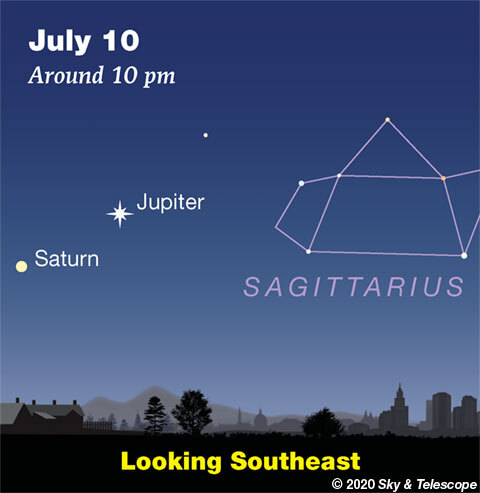
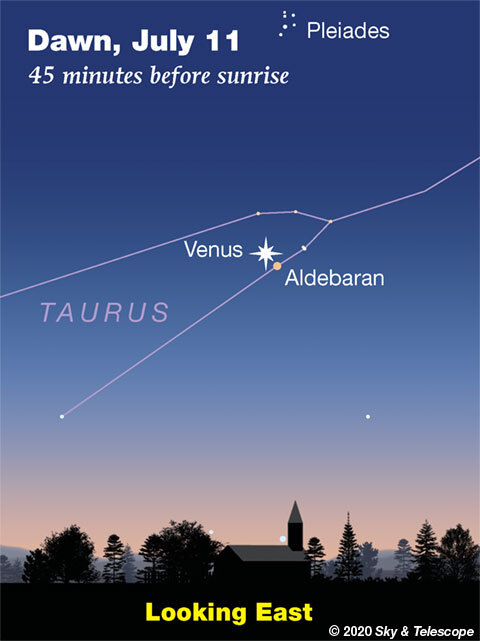
SATURDAY, JULY 11
■ If you have a dark enough sky, the Milky Way now forms a magnificent arch high across the whole eastern sky after nightfall is complete. It runs all the way from below Cassiopeia in the north-northeast, up and across Cygnus and the Summer Triangle in the east, and down past the spout of the Sagittarius Teapot in the south-southeast.
Meanwhile the Big Dipper, high in the northwest after dark, is dipping down to "scoop up water" through the evenings of summer and early fall.
This Week's Planet Roundup
Mercury is hidden deep in the glow of sunrise.
Venus (magnitude –4.7) shines brightly in the east during dawn, as shown below. Look for Aldebaran, much fainter at 1st magnitude, under it. Their separation shrinks from 3½° on the morning of July 4th to 1° on the 11th and 12th. Also, before dawn grows bright, catch the Pleiades about 11° above Venus. Binoculars help. And use the binocs to try for the Hyades stars right around Venus as plotted in the second frame below.
In a telescope Venus is a large crescent, shrinking this week from 41 to 37 arcseconds tall and waxing from 21% to 27% sunlit.
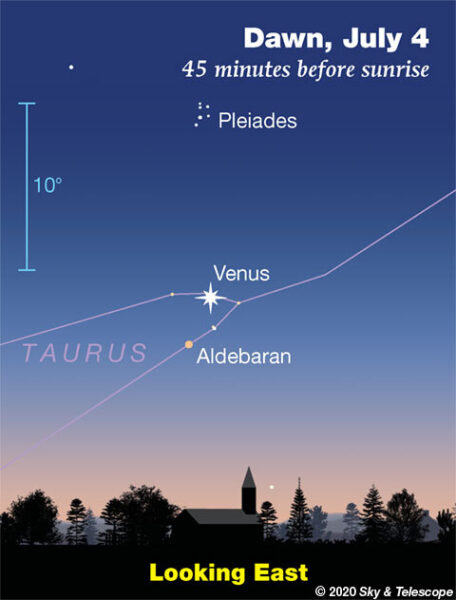
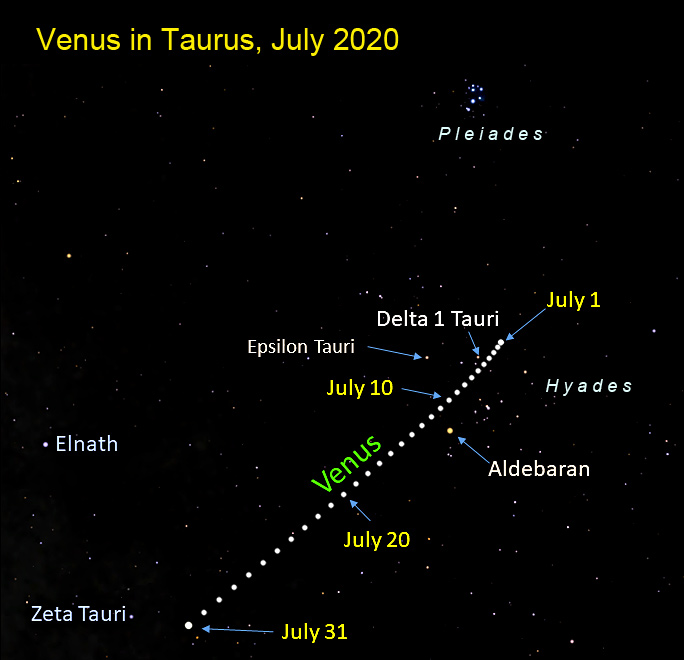
Mars rises due east around midnight or 1 a.m. daylight saving time, shining bright orange (magnitude –0.6) at the border of Pisces and Cetus. Watch for it to come up below the Great Square of Pegasus, to the lower right of the Square's bottom star (the Square balances on that star). By the first light of dawn Mars is grandly high and prominent in the southeast, shining yellow-orange like a distant bonfire in the sky.
In a telescope Mars has grown to 12 arcseconds in apparent diameter; we're approaching it as Earth speeds along in our faster orbit around the Sun. Mars looks obviously gibbous, 85% sunlit. Look for its white South Polar cap and for subtler dark surface markings. For a map of the side of Mars facing you at your date and time, use our Mars Profiler. The map is rectangular; remember to mentally wrap it onto half a globe.
Mars will grow to 22.6 arcseconds wide when it passes closest by Earth around opposition in the first half of October.
Jupiter and Saturn (magnitudes –2.7, and +0.2, respectively) rise in twilight, loom low in the southeast after dark, and climb as the evening grows late. Jupiter is brightest; Saturn is about 6° to its lower left. Farther to Jupiter's right is the Sagittarius Teapot.
The two planets are highest around 1 a.m. daylight-saving time. All July they're at their telescopic best; Jupiter reaches opposition on the night of July 13th, Saturn on the 20th.
Keep up with the telescopic interplay of Jupiter with its moons and their shadows, and find the transit times of Jupiter's Great Red Spot, in the July Sky & Telescope, page 50.
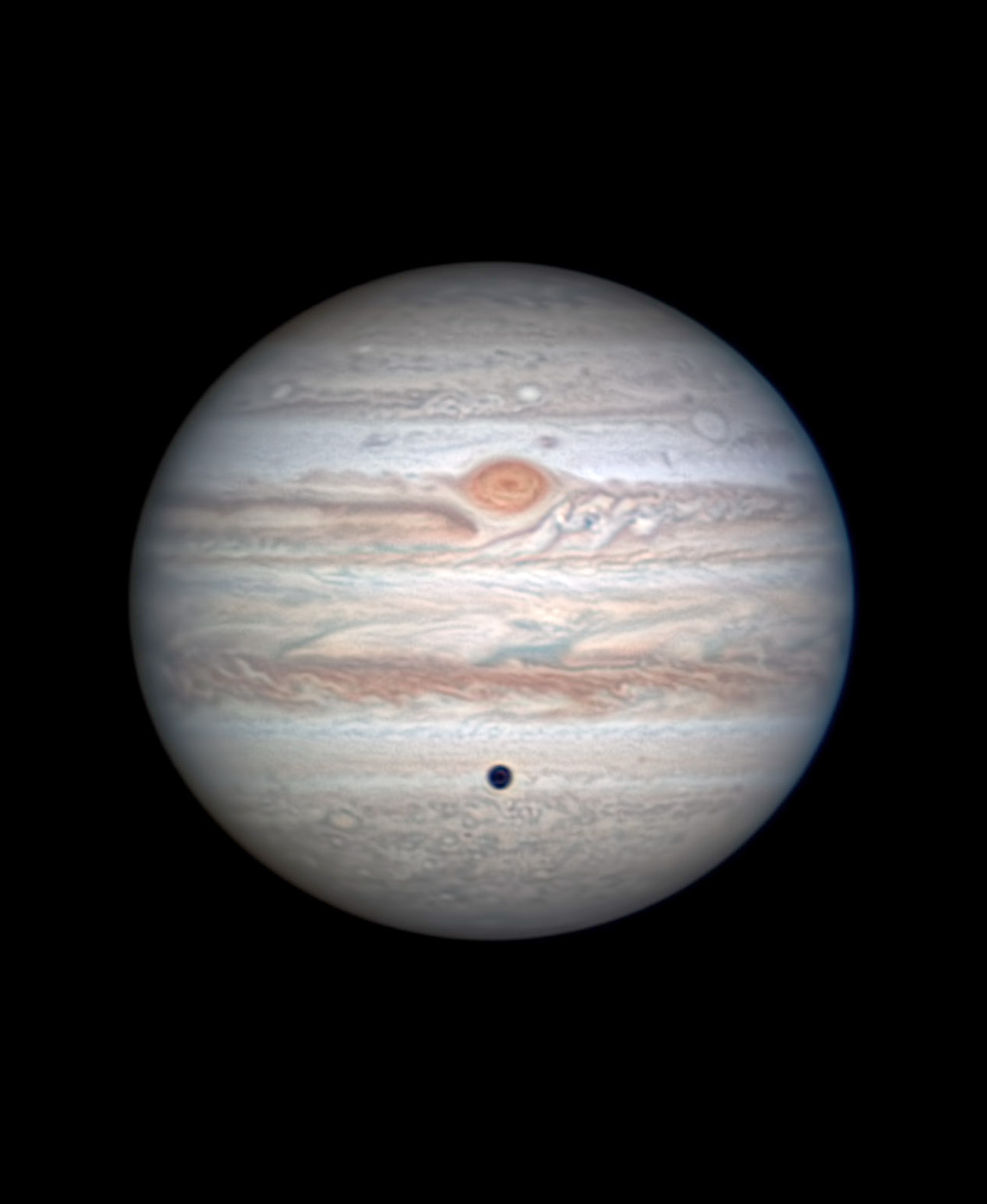
"This image shows a very rare treat," writes Go. "Callisto is in transit with the Great Red Spot. That dark spot is Callisto, not a shadow! I have not imaged a Callisto transit in years." Callisto has the darkest surface of Jupiter's major moons, and that's been enhanced by the boosted contrast here. But even visually, Callisto in transit is often mistaken for a satellite's shadow.
Go continues, "The Great Red Spot looks very interesting today. ... The wake of the GRS shows very complex turbulence. The 'chimney' north of the GRS [just below it and bending left] is now open. Oval BA can be seen rising." That's the large gray-white spot near the upper-right limb. "Its dark ring is well resolved."
Uranus (magnitude 5.8, in Aries) is up in the east just before dawn, about midway between Venus and Mars.
Neptune (magnitude 7.9, in Aquarius) is high in the southeast before dawn, west of Mars.
All descriptions that relate to your horizon — including the words up, down, right, and left — are written for the world's mid-northern latitudes. Descriptions that also depend on longitude (mainly Moon positions) are for North America.
Eastern Daylight Time (EDT) is Universal Time (also known as UT, UTC, GMT, or Z time) minus 4 hours.
Want to become a better astronomer? Learn your way around the constellations. They're the key to locating everything fainter and deeper to hunt with binoculars or a telescope.
This is an outdoor nature hobby. For an easy-to-use constellation guide covering the whole evening sky, use the big monthly map in the center of each issue of Sky & Telescope, the essential magazine of astronomy.
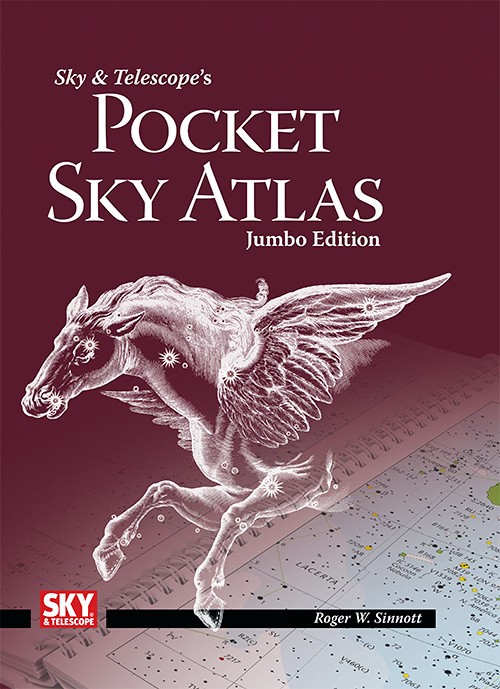
Once you get a telescope, to put it to good use you'll need a detailed, large-scale sky atlas (set of charts). The basic standard is the Pocket Sky Atlas (in either the original or Jumbo Edition), which shows stars to magnitude 7.6.
Next up is the larger and deeper Sky Atlas 2000.0, plotting stars to magnitude 8.5; nearly three times as many. The next up, once you know your way around, are the even larger Interstellarum atlas (stars to magnitude 9.5) or Uranometria 2000.0 (stars to magnitude 9.75). And read how to use sky charts with a telescope.
You'll also want a good deep-sky guidebook, such as Sky Atlas 2000.0 Companion by Strong and Sinnott, or the bigger (and illustrated) Night Sky Observer's Guide by Kepple and Sanner.
Can a computerized telescope replace charts? Not for beginners, I don't think, and not on mounts and tripods that are less than top-quality mechanically, meaning heavy and expensive. And as Terence Dickinson and Alan Dyer say in their Backyard Astronomer's Guide, "A full appreciation of the universe cannot come without developing the skills to find things in the sky and understanding how the sky works. This knowledge comes only by spending time under the stars with star maps in hand."
![]() Audio sky tour. Out under the evening sky with your earbuds in place, listen to Kelly Beatty's monthly podcast tour of the heavens above. It's free.
Audio sky tour. Out under the evening sky with your earbuds in place, listen to Kelly Beatty's monthly podcast tour of the heavens above. It's free.
"The dangers of not thinking clearly are much greater now than ever before. It's not that there's something new in our way of thinking, it's that credulous and confused thinking can be much more lethal in ways it was never before."
— Carl Sagan, 1996
"Facts are stubborn things."
— John Adams, 1770
 16
16









Comments
Rod
July 3, 2020 at 10:01 am
mary beth. I was out all night last night and this morning. 0005 EDT to 0530 EDT viewing or 0405 UT to 0930 UT. Sunrise near 0547 EDT/0947 UT. Eventful observations using my 90-mm refractor and 10-inch Newtonian. Observations 53x to 158x. Jupiter, Ganymede transit, Ganymede shadow transit, and Great Red Spot. I enjoyed views of Saturn, rings, 4 Saturnian moons, and Cassini division. The waxing gibbous Moon made viewing some of the Saturnian moons difficult with the 10-inch (normally I see 5). Later near 0240 EDT/0640 UT, Mars was high enough for observations using the 90-mm refractor in a different part of the field. Near 0400 EDT, I enjoyed using the 10-inch on Mars. By 0500, I tried to see comet NEOWISE using my 10x50 binoculars but did not. Still low below 5-degrees ENE direction at my location (Stellarium 0.20.2 and Starry Night show). Venus in the early morning sky is brilliant now, I looked at 0510 EDT/0910 UT and well placed at this time for telescope views. My companions through the night were deer, owl, and little critters moving around in the pastures and woods. I shined my red light into the surrounding area and could see little red eyes staring back at me, moving around close to ground level 🙂
You must be logged in to post a comment.
New Jersey Eclipse Fan
July 4, 2020 at 10:57 pm
She's "busy" right now, but Mary Beth's human companion says "great!" 😉
You must be logged in to post a comment.
mary beth
July 5, 2020 at 2:33 pm
Hi Rod! I have no idea who that New Jersey eclipse fan Commenter is, do you? Weird! Think we have a troll!
You sure have been making the most of the lockdown! We got to enjoy the beautiful full moon last night. It’s been pretty cloudy/dusty every evening so I’m looking forward to some clear nights predicted later in the week. It’s nice that Jupiter is visible before midnight. Do you look for or see the Hubble very often?
You must be logged in to post a comment.
Rod
July 5, 2020 at 3:45 pm
Hubble? I think you mean HST so my answer is no. I focus on natural objects. I will try again tomorrow morning near 0445 EDT to see comet NEOWISE, low in NE sky, my area near 7-degrees altitude using my 10x50 binoculars. Venus and Capella will frame the area to view, drop below Capella. Thanks for clearing up 'New Jersey Eclipse Fan' post 🙂
You must be logged in to post a comment.
Rod
July 5, 2020 at 3:55 pm
oh, mary beth glad to hear you are using stellarium now too. I use stellarium 0.20.2, the latest version for download and Starry Night Pro Plus 8. Concerning New Jersey Eclipse Fan, I am sure S&T will not mind the person posting their own stargazing notes too :)--Rod
You must be logged in to post a comment.
New Jersey Eclipse Fan
July 5, 2020 at 6:37 pm
I'm just having some fun; no harm intended. La verdad es que, I would love to get up early to view comet NEOWISE but I just retired from teaching in N.J. public schools after 18+ years and like to sleep in! I have a better chance staying up late the night before, but trees and houses block my view to the northeast, so I'd have to get in my car and drive a few miles away to find a viewing spot, which is not my favorite activity at 5:00AM. There is a Wawa around the corner from me, so at least I can get a fresh cup of coffee on the way there if I do decide to make the trek. Keep us posted!
You must be logged in to post a comment.
mary beth
July 6, 2020 at 1:07 am
That’s the good thing about fall and winter, you can s t a r g a z e at 7 PM!
You must be logged in to post a comment.
cyrtonyx
July 8, 2020 at 9:34 am
Rod, Mary Beth:
Rose early this morning to view comet NEOWISE. Up at 0400 MDT and scanned the NE horizon, Nothing, Figured a bit too early so in the interim i views Mars, Saturn & Jupiter. Venus blazed like a beacon in the east. Locals have been reporting it as a UFO lately, after all this is New Mexico. At about 0420 I again scanned the NE horizon with 10x bins and saw NEOWISE rising. Beautiful! It reminded me of comet Bennet I viewed as a 9 year old around Easter 1970. I watched NEOWISE rise for another 20 minutes before the dawn started to wash it out, The waning moon made skies not completely dark, but the comet was visible to my unaided eyes with a noticable tail. What a treat!
You must be logged in to post a comment.
Rod
July 6, 2020 at 6:09 am
Hey mary beth and New Jersey Eclipse Fan. Both of you may enjoy my post about seeing comet NEOWISE early this morning at https://skyandtelescope.org/astronomy-news/anticipation-grows-for-comets-neowise-and-lemmon/#comment-199557
Fairly easy viewing using 10x50 binoculars but morning haze and some clouds provided less than perfect seeing though.
You must be logged in to post a comment.
New Jersey Eclipse Fan
July 6, 2020 at 1:45 pm
Why yes, I did! I might just have to re-nickname myself "New Jersey Eclipse and Comet Fan." Thanks!
You must be logged in to post a comment.
mary beth
July 7, 2020 at 7:41 pm
Leave room for ‘meteor shower Fan’ for August!
You must be logged in to post a comment.
New Jersey Eclipse Fan
July 7, 2020 at 10:23 pm
Plenty of room in my nickname! I would even add "Milky Way," if I could only see it from my Central Jersey location. The last time was about seven summer ago when I was in upstate N.Y. visiting my daughter, who was a staff member at a sleep-away camp.
You must be logged in to post a comment.
mary beth
July 8, 2020 at 12:01 pm
NJE&C&MS&MW Fan!! You should make a drive to the country since this is prime season for the Milky Way!
You must be logged in to post a comment.
New Jersey Eclipse Fan
July 9, 2020 at 5:19 pm
What a great idea! In the meantime, I'll just EAT a Milky Way. 😉
You must be logged in to post a comment.
mary beth
July 10, 2020 at 12:44 am
Haha! Good one! I’ll take a Mars bar please. ( do they still make those?)
You must be logged in to post a comment.
New Jersey Eclipse Fan
July 10, 2020 at 5:41 pm
I think so. Hey--fresh comments and photos of NEOWISE on the new weekly email, so check it out. Plus a drawing by some guy named Bob King. 😉
You must be logged in to post a comment.
You must be logged in to post a comment.